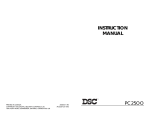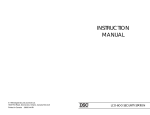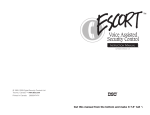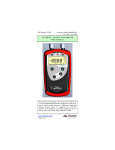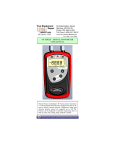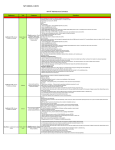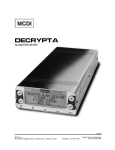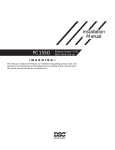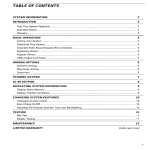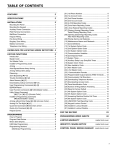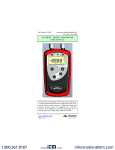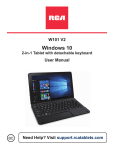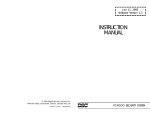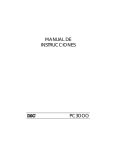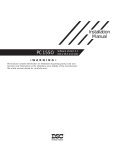Download INSTALLATION MANUAL PC25OO
Transcript
INSTALLATION MANUAL PC25OO NOTES ON UL INSTALLATION This equipment is UL listed in accordance with UL standard 1023 (Household Burglar Alarm System Units), UL standard 985 (Household Fire Warning Units) and UL standard 1635 (Digital Alarm Communicator System Units). This equipment has the capability of being programmed for operational features that are not allowed for UL recognized installations. To stay within the standard for Household applications, the Installer should stay within the following guidelines when configuring the system. 1. All components of the system should be listed for the intended application. Note elsewhere in this manual, recommendations for smoke detectors and battery to be used with this equipment. 2. If this system is configured for “Fire”, the installer should refer to NFPA Standards #74 for details on locating smoke detectors. When the “Fire” feature is enabled, there must be at least one UL recognized indoor Fire Alarm Warning Signalling Appliance. 3. Maximum allowed Entry Time = 45 seconds Maximum allowed Exit Time = 60 seconds Minimum allowed Bell Cutoff Time = 4 minutes 4. The “Split-Arming” feature is not allowed for UL recognized installations. The equipment must be configured as a Single System. 5. User Bypass must be enabled so that a User Code is required to Bypass zones. 6. The installer should caution the User to NOT give system information to casual users. e.g. Codes, Bypass methods, etc. to babysitters or home service people. Only the “One-Time” Use Code should be given to the casual user. 7. The Installer should advise the User and note in the User Manual: i) Service organization name and telephone number ii) The programmed Exit time iii) The programmed Entry time TABLE OF CONTENTS 1. SPECIFICATIONS ...................................................................................................................... 3 2. FEATURES ................................................................................................................................. 4 3. INSTALLATION Bench Testing ........................................................................................................................ 5 Mounting Panel ...................................................................................................................... 6 Hook-up Procedure ................................................................................................................ 6 Terminals Connections (Description of all Terminals) ............................................................ 6 Keypad Installation ................................................................................................................. 8 Power-up Procedure .............................................................................................................. 8 Hook-up Diagram ................................................................................................................... 9 Fire Alarm Diagram .............................................................................................................. 10 System Testing .................................................................................................................... 11 Instructing the End User ....................................................................................................... 11 4. KEYPAD FUNCTIONS Introduction .......................................................................................................................... 11 Master Code ......................................................................................................................... 12 Installer’s Code .................................................................................................................... 12 Arming .................................................................................................................................. 12 Auto-Bypass/Home-Away Arming ........................................................................................ 12 Entry Delay Off Arming ................................ [ ][9][User Code] ........................................... 13 * Disarming ............................................................................................................................. 13 Zone Bypassing (Shunting) .......................... [ ][1] .............................................................. 13 * Trouble Display ............................................ [ ][2] .............................................................. 13 * Alarm Memory Display ................................. [ ][3] .............................................................. 14 * Switched Aux. Power Supply ....................... [ ][Hold Down 4] ........................................... 14 * Programming new User Codes .................... [ ][5][Master Code] ....................................... 15 * Programming Other User Functions ............ [ ][6][Master Code] ....................................... 15 * - Setting the Internal Clock ............................................................................................... 16 - Automatic Arm ............................................................................................................... 16 - Quick Arm ...................................................................................................................... 16 - Door Chime .................................................................................................................... 16 - Installer’s Test ................................................................................................................ 16 - Bell Test ......................................................................................................................... 16 Utility Output Command ............................... [ ][7] or [ ][7][User Code] ............................. 17 * * Installer’s Programming Commands ............ [ ][8][Installer’s Code] ................................... 17 * “Quick-Arm” Command ................................ [ ][0] .............................................................. 17 * Keypad Zones ...................................................................................................................... 17 5. PROGRAMMING GUIDE [ ][8][Installer’s Code] Commands * [00] [01] [02] [03] [04] [05] [06] [07] Binary Programming (Special Applications Only) ........................................................ 18 1st Telephone Number ................................................................................................ 19 1st Account Code Number .......................................................................................... 19 2nd Telephone Number ............................................................................................... 19 2nd Account Code Number ......................................................................................... 19 Alarm Reporting Codes Zones 1 to 8 .......................................................................... 19 Restoral Reporting Codes Zones 1 to 8 ...................................................................... 20 Utility Alarm Reporting Codes ..................................................................................... 20 1 [08] [09] [10] [11] [12] [13] [14] [15] [16] [17] [18] [19] [20] [21] [22] [23] [24] [25] [26] [27] [28] [50] Utility Restoral Reporting Codes ................................................................................. 21 Closing Reporting Codes by User Codes 1 to 8 .......................................................... 21 Opening Reporting Codes by User Codes 1 to 8 ........................................................ 22 Miscellaneous Reporting Codes .................................................................................. 22 Definitions for Zones 1 to 8 ......................................................................................... 22 1st System Definition Code ......................................................................................... 23 2nd System Definition Code ........................................................................................ 24 Zone Shunt Mask ........................................................................................................ 24 System Times ............................................................................................................. 25 Entry Delay (Seconds) Exit Delay (Seconds) Bell Cut Off Time (Minutes) AC Failure Transmission Delay (Minutes) Standard Loop Response Time (× 10 ms) Test Transmission Repeat Time (Days) System Clock Times (HH:MM in 24-hour Format) ...................................................... 25 Auto Arm Time Test Transmission Time New Installer’s (Programmer’s) Code ......................................................................... 25 New Master Code ....................................................................................................... 25 Future Use .................................................................................................................. 25 Communications Format ............................................................................................. 25 1st Telephone Number Format 2nd Telephone Number Format Programmable Input and Output Options ................................................................... 27 Auxiliary Input Options Programmable Output Options Group A Zone Assignments ........................................................................................ 28 Group B Zone Assignments ........................................................................................ 28 Access Code Group A Assignment ............................................................................. 28 Access Code Group B Assignment ............................................................................. 28 Transmission to 1st or 2nd Telephone Number Options ............................................. 29 Group A Alarms and Restorals Group B Alarms and Restorals Group A Openings, Closings and Partial Closings Group B Openings, Closings and Partial Closings Priority Alarms and Restorals Maintenance Alarms and Restorals Reset EEPROM Memory to Factory Defaults ............................................................. 29 EEPROM Copy Routine (Making Master Chips) ......................................................... 29 6. PROGRAMMING WORKSHEETS ........................................................................................... 31 7. LIMITED WARRANTY .............................................................................................................. 36 COPYRIGHT 1989 DIGITAL SECURITY CONTROLS LTD. 1645 FLINT ROAD, DOWNSVIEW, ONTARIO, CANADA M3J 2J6 TELEPHONE: (416) 665-8406 2 When the transformer is plugged in there should be lights on the keypad and the buzzer connected to the bell terminals may go on for a few seconds. The “ARMED” light may be on or off the first time the panel is powered. The last armed/disarmed condition is stored in the EEPROM memory so the panel will always power up in the last armed/disarmed state. If the “ARMED” light is on, enter the default master code [1234] to disarm the panel. If the keypad is not active, check for the presence of AC power at the “AC” terminals, check the keypad connections and check the panel fuses. If all the zones are properly connected with end of line resistors all of the zone lights will be off. Note that the panel will arm only if all zones are properly connected with end of line resistors (including FIRE circuit) so that the “READY” light is on. The keypad should beep several times to indicate acceptance of the master code. Enter the master code to arm or disarm the panel. Read the “KEYPAD COMMANDS” section of this manual or the USER INSTRUCTION MANUAL and enter commands on the keypad to become familiar with the different commands. Turn to the “PROGRAMMING GUIDE” in this manual and enter a sample program into the panel through the keypad to become familiar with the programming commands. Mounting the Panel Select a dry location close to an unswitched AC source, close to a ground connection and close to the telephone connection. Remove printed circuit board, mounting hardware and keypad from cardboard retainer inside panel. Before attaching cabinet to wall, press the five white nylon printed circuit board mounting studs and the ground connection screw into the cabinet from the back. Pull all cables into cabinet and prepare them for connection before mounting the circuit board to the back of the cabinet. Press circuit board down onto mounting studs. Hook-up Procedure DO NOT connect transformer or battery until all other wiring has been connected. See power-up procedure. Connect a ground cable from the cabinet ground connection by the shortest and most direct route to a cold water pipe or a grounding rod. Connect zone cables to zone loop inputs. Put end of line resistors on any unused zones. Connect wires supplying power to motion detectors to auxiliary supply. Install keypads and connect wires to keypad terminals on panel. Connect RJ31-X cord to telephone terminals. Do not insert plug into RJ31-X jack. NOTICE: Ensure that plugs and jacks meet the dimension, tolerance and metallic plating requirements of 47 C.F.R. Part 68, Subpart F. WARNING: FCC restricts using this equipment on certain types of telephone lines. Read FCC COMPLIANCE STATEMENT at the end of this manual. Also, do not use this equipment on a telephone line equipped with “call waiting” feature as the tone generated may interfere with the communicator operation. Connect bell or siren to “BELL+” and “BELL-” terminals. Observe correct polarity for sirens and polarized bells. Connect 1K ohm 1/2 watt resistor across terminals to eliminate trouble condition if bell circuit is not being used. Terminal Connections AC Power Terminals “AC” Use a 15.5 VAC transformer with a minimum 40 VA rating to supply AC power to the PC2500. The transformer should not be connected to an outlet that is controlled by a switch. If AC failure occurs it is displayed as a trouble on the keypad (see KEYPAD COMMANDS [ ][2] trouble conditions). It can also * be transmitted to the monitoring station as a trouble condition (see PROGRAMMING GUIDE [ ][8] * section 07 and 08 for alarm and restore codes and section 16 for transmission delay). 6 If after signal silence, the smoke detector is not restored to normal, the signals will re-sound after 90 seconds and 30 seconds after that, the communicator will transmit. If the signals re-sound, they may again be silenced, [#] key, and the communicator will be aborted if silence occurs within the 30 second delay period. To restore the smoke detector to normal, clear all products of combustion from the detector and reset the detector by pressing [ ] and then holding down [4] for 2 or 3 seconds. This action will remove power from * if it is clear of smoke, the detector will return to normal. If the detector is still in the smoke detector, and alarm, the signals will sound immediately and the above sequence will repeat. For an open on the FIRE loop, the keypad sounder will beep twice every 10 seconds and the “TROUBLE” light will show on the keypad. The communicator will transmit the trouble condition if programmed for trouble transmission. The audible trouble signal may be silenced by pressing the [#] key. To determine the nature of the trouble, press [ ], [2] (see the “TROUBLE DISPLAY” section). * Zone Input Terminals “Z1” to “Z8” NOTE: For UL installations, zone inputs must be terminated with normally closed initiating devices or end-of-line resistors (1K ohm). Zone inputs “Z1” to “Z8” are supervised end-of-line (E.O.L.) resistor circuits. Each input must be terminated with a 1K ohm E.O.L. resistor. An alarm condition will be created if a normally open contact is used to short across the E.O.L. resistor. An alarm is also created if normally closed contacts, wired in series with the E.O.L. resistor, are opened. See the wiring diagram for normally open and normally closed contact connection. The type of circuit or zone definition (delay, instant, 25 hour, etc.) is programmed from the keypad using the [ ], [8] installer programming commands (PROGRAMMING * GUIDE section 12). Telephone Terminals “TIP”, “RING”, “T-1” and “R-1” The wires from the RJ31-X telephone jack are connected to these terminals in the following way. TIP green wire from RJ31-X cord RING red wire from RJ31-X cord T-1 brown wire from RJ31-X cord R-1 grey wire from RJ31-X cord NOTICE: Ensure that plugs and jacks meet the dimension, tolerance and metallic plating requirements of 47 C.F.R. Part 68, Subpart F. For proper operation there must be no other telephone equipment connected between the control panel and the telephone company’s facilities. Do not connect the alarm panel communicator to telephone lines intended for use with facsimile (FAX) machines. These lines may incorporate a voice filter which disconnects the line if other than FAX signals are detected, resulting in incomplete transmissions. Battery Connections Do not connect the battery or the transformer until the wiring is complete. Connect the red battery lead to the positive battery terminal and the black lead to the negative battery terminal. If the connection is made in the reverse, the battery fuse will blow. The battery charging voltage is factory adjusted for 13.8 volts and normally needs no adjustment. If the battery charging voltage is out of adjustment, contact your service representative. NOTE: The battery charging voltage must not be adjusted on UL listed systems. Keypad Installation Mount the keypads near the exit-entry doors. The PC2500RK keypad has a red, a black, a green and a yellow wire on the back. Connect these four wires to the four keypad terminals on the control panel using four conductor (quad) telephone wire. Up to five keypads may be connected to one PC2500. Connect all green wires from the keypads to the “GRN“ terminal on the panel. Connect all yellow wires from the keypads to the “YEL” terminal on the panel. Connect all red wires from the keypads to the “RED” terminal. Connect all black wires from the keypads to the “BLK” terminal. The blue wire loop on the back of the keypad can be programmed to switch on the programmable output “PGM OUT” (see section [22] PROGRAMMING GUIDE). Cut the blue loop and connect one or more normally closed contacts in series. When the loop is opened the “PGM OUT” terminal switches to ground. Power-up Procedure If the keypads are located a distance from the panel, install an extra keypad temporarily at the panel during power up and testing. An extra keypad with a short length of cable and alligator clips attached is 8 helpful for testing and programming PC2500 systems. Connect the transformer. Utility Output Command [*]+[7] or [*]+[7]+[USER CODE] The programmable output (PGM terminal) on the PC2500 can be made to activate by a command from the keypad. This output can be used for operating other devices such as a garage door opener, special lighting or door strikes. The programmable output must be selected for keypad utility using the [ ][8][Installer code][22] command * and programming items [2], [3], [4] or [5]. Depending on the option chosen in the programming section, the programmable output is activated by pressing the [ ] then [7] keys followed by a Group A access code, Group B access code, any access * code or no code at all. When the proper keys are pressed the keypad sounder and the programmable output are activated for 2 seconds. Installer’s Programming Commands [*]+[8]+[INSTALLER CODE] The PC2500 is completely programmed from the keypad using commands in the [ ][8] section. The * commands are described in detail in the programming section of this manual. “At Home” Arming Command [*]+[9]+[USER CODE] Entering [ ][9] before the arming code arms the panel without any entry delay on the delay zones. This * command is used for arming the system while at home. The “Armed” LED will flash while the panel is in the “at-home” armed mode. “Quick-Arm” Command [*]+[0] Entering [ ][0] is accepted as a valid arming code when the “QUICK-ARM” feature is activated. This * command is often used when individuals are required to arm the system but it is not wanted that they be able to disarm the system. This could be used with home visitors in the case of a residential alarm or junior employees and maintenance staff in the case of a commercial alarm. See instructions in the “[ ][6] * USERS’ PROGRAMMING COMMANDS” section for activating the “QUICK-ARM” feature. Keypad Zones There are three zones which can be activated from the keypad. The alarm and restoral codes for keypad zones are programmed using the [ ][8] command. * Pressing the [1] and [3] keys at the same time activates a Fire alarm. The fire alarm sounds the siren/bell in a pulsed mode and is annunciated as a memory condition. Pressing the [4] and [6] keys at the same time activates an Auxiliary keypad zone. If a reporting attempt is made to an alarm receiver and it is successful the PC2500 will acknowledge the transmission with a short series of beeps from the keypad. Pressing the [ ] and [#] keys at the same time activates the Police (or Panic) alarm. The panic alarm can * be programmed for audible or silent operation (see section [13] in PROGRAMMING GUIDE). There is no light annunciation from the keypad for the last two keypad zones, however, the keypad buzzer beeps 3 times to confirm activation on any of the keypad zones. If the keys are held down the buzzer continues to beep. See section [11] for alarm and restoral codes for all three keypad zones. NOTE: The [1] and [3] keypad activated zone should be used for FIRE only. 18 See “TERMINAL CONNECTIONS” section of manual for a description of the operation of the FIRE ZONE and the AUXILIARY INPUT ZONE. Section [22] contains options for the AUXILIARY INPUT ZONE. The BATTERY TROUBLE reporting code will be sent when the battery voltage drops below 11.5 volts. This reporting code will also be sent because of a battery fuse failure. The battery is tested under load every 10 seconds. Only one transmission will be sent during an arm or disarm period to prevent multiple transmissions from a weak battery. The AC FAILURE TROUBLE reporting code will be sent after the delay time programmed in section [16]. This prevents transmissions during temporary power failures. AUXILIARY POWER SUPPLY TROUBLE reporting code is sent when the auxiliary power supply fuse is defective. The BELL CIRCUIT TROUBLE reporting code is sent when the bell circuit is open or the fuse is defective. The FIRE ZONE TROUBLE code is sent when the fire zone becomes open circuit (E.O.L. resistor is disconnected). The FOIL ZONE TROUBLE code is sent when any zone defined as a foil loop (see section [12]) goes into alarm during the day when the system is disarmed. See [ ][2] TROUBLE * COMMAND for additional description of trouble codes and transmissions. [08] Utility Restoral Reporting Codes (Communicator) These reporting codes are used by the communicator to transmit the following list of restoral conditions which correspond to alarm conditions in section [07]. Use instructions in section [05] as a guide for programming. FIRE ZONE AUXILIARY INPUT ZONE BATTERY TROUBLE NOTE: For UL installations, AC TROUBLE either AC failure or battery FOIL ZONE(S) TROUBLE trouble reporting codes must BELL CIRCUIT TROUBLE be enabled. FIRE ZONE TROUBLE AUX POWER SUPPLY TROUBLE [09] Reporting Codes for Closing (Arming) Via User Codes 1 to 8 The reporting codes in sections [09] and [10] are used to identify “OPENINGS AND CLOSINGS” (disarming and arming of the system) by user access code. After entering the section code [09], enter 8 two-digit reporting codes. The 8 reporting codes correspond to the 8 user access codes which as programmed using the [ ][5] command. When the system is armed * using one of the user access codes, the corresponding reporting code is transmitted. When transmitting in 4/2, 3/1 extended or any of the other extended formats (see examples in section [05]), the 8 closing codes are programmed as follows: [C1], [C2], [C3], [C4], [C5], [C6], [C7], [C8] The first digit, “HEX C”, is one which is used to represent a closing signal (this could be another number depending on what is used at the monitoring station), and the second digit represents the user access code which was used to arm the system. The closing code transmission takes place after the exit delay time. Therefore, if the system is armed and disarmed before the expiry of the exit time, no closing transmission will take place. Remember that the first user access code is the master code and that the 8th code is the temporary or maid’s code. The 8th user code can be converted to a normal code using on of the options of the system definition code in section [13]. When the system has been armed using “QUICK ARM” [ ][0] or “AUTO ARM” (see [ ][6] keypad * * commands), the first reporting code (reporting code for master code) will be transmitted. The master code has control over whether these functions are enabled or disabled. When the system is armed with one or more zones bypassed (see [ ][1] command for zone bypassing), * the monitoring station can be notified by programming PARTIAL ARM reporting in section [11]. Note that the PARTIAL CLOSING code is sent in tandem with the regular closing code to identify it as a partial closing condition. 22 [10] Reporting Codes for Openings (Disarming) VIA User Codes 1 to 8 The 8 reporting codes correspond to the 8 user access codes which are programmed using the [ ][5] * command. When the system is disarmed using one of the user access codes, the corresponding reporting code in this section is transmitted. See section [09] for an example of “OPENING AND CLOSING” reporting code programming. [11] Reporting Codes for Miscellaneous Functions The reporting codes programmed in this section include the partial arm code described in section [10]; alarm and restoral codes for the keypad zones and the periodic test reporting code (every 1 to 99 days). The periodic test cycle time is set in section [16] and the reporting time of day is set in section [17]. The reporting codes are programmed in the following order: PARTIAL CLOSING KEYPAD PANIC ALARM [ ][#] * KEYPAD FIRE ALARM [1][3] KEYPAD AUXILIARY ALARM [4][6] KEYPAD PANIC RESTORAL [ ][#] * KEYPAD FIRE RESTORAL [1][3] KEYPAD AUXILIARY RESTORAL [4][6] PERIODIC TEST TRANSMISSION [12] Zone Definition for Zones 1 to 8 (Control Panel) As in the reporting codes, once this section number is entered, 8 two-digit numbers are required. Each 2 digit number entered describes how a zone will operate. The 8 two-digit numbers entered correspond to zone definitions for zones 1 to 8. The first digit entered determines whether the zone will be audible or silent and fast or slow response time (loop response time is programmed in section [16]). The second digit determines the type of zone (i.e. delay, instant, interior or 24 hour zone). 23 [16] SYSTEM TIMES (Control Panel and Communicator) Once the section is entered 6 two digit numbers are expected to be entered. The valid range for entries in this section is 01 to 99. Hex values are not allowed. The times are entered in the following order. ENTRY DELAY TIME (IN SECONDS) EXIT DELAY TIME (IN SECONDS) BELL CUT OFF TIME (IN MINUTES) DELAY BEFORE AC FAILURE TROUBLE REPORTING (IN MINUTES) SLOW LOOP RESPONSE TIME (IN 10msec INCREMENTS) TEST TRANSMISSION CYCLE TIME (IN DAYS) Up to a 99 minute delay may be programmed before the AC FAILURE reporting code is transmitted. The reporting code for AC FAILURE TROUBLE is programmed in section [7] and [8]. The loop response time is the length of time than an alarm condition must be present on a loop before it is detected. Certain vibration detectors, shock sensors and glass break detectors require a fast response loop in order to operate. The loops to which these types of detectors are connected should be programmed as fast response loops. All other loops should be programmed as slow response loops. Loops are defined as either fast or slow response time in section [12]. The fast response time is fixed at 10 milliseconds. The SLOW LOOP RESPONSE TIME is programmable in increments of 10 milliseconds. The normal entry would be 20 for a 200 msec slow response time. The test transmission sent to the monitoring station on a regular basis to confirm that the communication link to the system is intact. The TEST TRANSMISSION CYCLE TIME is how often (in days) the test transmission is sent. The reporting code for the test transmission is programmed in section [11]. The time of day that the test transmission is sent is programmed in section [17]. [17] SYSTEM CLOCK TIMES After the section number [17] is entered, 3 four digit numbers are expected. These numbers are the following system times. AUTOMATIC ARMING TIME OF DAY (HH:MM) TEST TRANSMISSION TIME OF DAY (HH:MM) Times are entered using the “24 hour clock” (military time). Valid entries are 00 to 23 for HH (i.e. hours) and 00 to 59 for MM (i.e. minutes). NOTE: IF INVALID TIMES ARE ENTERED FUNCTIONS WILL NOT WORK. The automatic arm function is enabled and disabled using the [*][6][MASTER CODE] USER PROGRAMMING COMMAND. The installer can totally disabled the auto arm function and therefore not make it available to the end user by entering invalid times such as 99:99 for HH:MM. [18] NEW INSTALLER’S CODE [19] NEW MASTER CODE (1ST USER ACCESS CODE) Enter a new 4 digit code in each of the sections above once the section number has been entered. Only use digits 0 to 9 as code numbers. Do not press the [*] or [#] keys. If an error is made in entered in a code, continue to enter the four digits then enter the section number again an re-enter the correct code. Do not press the [*] or [#] while entering these codes. Do not make any of the two codes the same. [20] FUTURE USE - Do not enter section [20] [21] COMMUNICATOR FORMAT OPTIONS This section sets the type of format which will be sent to each of the two telephone numbers programmed in sections [1] and [3]. Enter one HEX digit (ie. when entering HEX A press [*][1][*]) for each. The number entered for each phone number is determined by the type of receiver being called. Enter the format number 25 for the “1st TELEPHONE NUMBER” first. It is necessary to program both format numbers for each telephone number even if the first phone number is the only one being used. Options are as follows: [0] SILENT KNIGHT / ADEMCO SLOW, 10 BPS (1400 Hz HANDSHAKE) 3/1 AND 4/2 NON EXTENDED FORMAT [1] SESCOA, FRANKLIN, DCI, VERTEX, 20BPS (2300 Hz HANDSHAKE) 3/1 AND 4/2 NON EXTENDED FORMAT [2] SILENT KNIGHT FAST, 20 BPS (1400 Hz HANDSHAKE) 3/1 AND 4/2 NON EXTENDED FORMAT [3] RADIONICS (2300/1400 Hz HANDSHAKE) 3/1, 4/2 NON EXTENDED FORMAT [4] RADIONICS (2300/1400 Hz HANDSHAKE) 3/1, 4/2 NON EXTENDED WITH PARITY FORMAT [5] NOT USED [6] NOT USED [7] FOR FUTURE USE [8] SILENT KNIGHT / ADEMCO SLOW, 10BPS (1400 Hz HANDSHAKE) 3/1 EXTENDED FORMAT [9] SESCOA, FRANKLIN, DCI, VERTEX, 20BPS (2300 Hz HANDSHAKE) 3/1 EXTENDED FORMAT [A] SILENT KNIGHT FAST, 20 BPS (1400 Hz HANDSHAKE) 3/1 EXTENDED FORMAT [B] RADIONICS, (2300/1400 Hz HANDSHAKE) 3/1 EXTENDED FORMAT [C] RADIONICS, (2300/1400 Hz HANDSHAKE) 3/1 AND 4/1 EXTENDED WITH PARITY FORMAT [D] FOR FUTURE USE [E] FOR FUTURE USE [F] FOR FUTURE USE Communications Compatibility All these communication formats are compatible with the Silent Knight model SK9000 and Ademco model 685 receivers. Other receivers may also be compatible with some of the formats listed. For UL installations, ensure that the control unit is reporting to one of the above receivers. 10 BPS and 20 BPS FORMATS 10 BPS is the standard slow format used on Silent Knight / Ademco receivers. DATA = 1900 Hz KISSOFF = 1400 Hz SPEED = 10 BAUD 20 BPS is the standard fast format used on DCI, Franklin, Sescoa and Vertex receivers. DATA = 1800 Hz KISSOFF = 2300 Hz SPEED = 20 BAUD Radionics Format For conventional Radionics 3/1 format, the communications mode should be set on either Radionics rounds [B] or Radionics parity [C]. The extended version of the Radionics format is normally used. The following guidelines are provided to help in configuring the PC1500 for Radionics format. 1. The customer account code must be only 3 digits with a zero making up the 4th digit (i.e. Enter 1230 to program an account code of 123). 2. The zone alarm reporting codes must all be single digit numerical codes with no extended 2nd round being sent (i.e. Zone 1 = 10, Zone 2 = 20... Zone 6 = 60). The zero in the 2nd digit position tells the PC1500 not to send an extended round. 3. All other non-alarm reporting codes must be set up to send an extended 2nd round. The 1st digit of the reporting code is used to identify the event while the 2nd or extended digit is used to associate the event with a particular item (i.e. A reporting code of E3 means restore zone 3. E = restore, 3 = zone 3). 4. The following is a list of 1st digit identifiers that should be used with the Radionics format. Restorals “E” Example: E3 = restore zone 3 Openings “B” Example: B2 = opening by user 2 Closings “C” Example: C4 = closing by user 4 Troubles “F” Example: F5 = trouble from source 5 Misc. “D” Example: D1 = partial closing 34 Programming Work Sheets [01] 1st Phone Number (Enter [0] for digit “0” in phone number) (Enter [ 4 ] (HEX D) for additional dial tone detection between phone number digits, as in local PBX ** systems) (Be sure to enter [#] to end phone number) [02] 1st Customer Account Code (For a 3 digit code, enter [0] for the last digit) (Enter [ 1 ] (HEX A) for digit 0 in account code) ** NOT REQUIRED WHEN USING A SINGLE SYSTEM. NOTE: FOR UL INSTALLATIONS, THE SECOND PHONE NUMBER MUST NOT BE ACTIVATED AS THE TOTAL NUMBER OF DIALLING ATTEMPTS WOULD BE GREATER THAN 10. [03] 2nd Phone Number [04] 2nd Customer Account Code [05] Zones 1 to 8 Alarm Reporting Codes ZONE ZONE ZONE ZONE ZONE ZONE ZONE ZONE 1 2 3 4 5 6 7 8 ALARM ALARM ALARM ALARM ALARM ALARM ALARM ALARM [06] Zones 1 to 8 Restoral Reporting Codes ZONE ZONE ZONE ZONE ZONE ZONE ZONE ZONE 1 2 3 4 5 6 7 8 ALARM ALARM ALARM ALARM ALARM ALARM ALARM ALARM [07] Utility Alarm Reporting Codes FIRE ZONE* AUXILIARY INPUT ZONE* BATTERY TROUBLE** AC FAILURE TROUBLE** FOIL ZONE(S) TROUBLE** BELL CIRCUIT TROUBLE** FIRE ZONE TROUBLE** AUX POWER SUPPLY TROUBLE** NOTE: For UL installations, either AC failure or battery trouble reporting codes must be enabled. * Priority alarms / restorals ** Maintenance alarms / restorals; see section [27] 32 [08] Utility Restoral Reporting Codes FIRE ZONE* AUXILIARY INPUT ZONE* BATTERY TROUBLE** AC FAILURE TROUBLE** FOIL ZONE(S) TROUBLE** BELL CIRCUIT TROUBLE** FIRE ZONE TROUBLE** AUX POWER SUPPLY TROUBLE** * Priority alarms / restorals ** Maintenance alarms / restorals; see section [27] [09] Closing (Arming) Reporting Codes for Access Codes 1 to 8 ACCESS ACCESS ACCESS ACCESS ACCESS ACCESS ACCESS ACCESS CODE CODE CODE CODE CODE CODE CODE CODE 1 2 3 4 5 6 7 8 [10] Opening (Disarming) Reporting Codes for Access Codes 1 to 8 ACCESS ACCESS ACCESS ACCESS ACCESS ACCESS ACCESS ACCESS CODE CODE CODE CODE CODE CODE CODE CODE 1 2 3 4 5 6 7 8 [11] Miscellaneous Functions Reporting Codes PARTIAL CLOSING*** KEYPAD PANIC ALARM [ ][#]* * KEYPAD FIRE ALARM [1][3]* KEYPAD AUXILIARY ALARM [4][6]* KEYPAD PANIC RESTORAL [ ][#]* * KEYPAD FIRE RESTORAL [1][3]* KEYPAD AUXILIARY RESTORAL [4][6]* PERIODIC TEST TRANSMISSION** * Priority alarms / restorals ** Maintenance alarms / restorals; see section [27] *** Transmission reports with section [9] & [10] (openings and closings). 33 FACTORY PROGRAMMED (DEFAULT) [17] SYSTEM CLOCK TIMES ENTER 4 DIGITS: 00 TO 23 FOR HOURS FOLLOWED BY 00 TO 59 FOR MINUTES) AUTOMATIC ARMING TIME OF DAY TEST TRANSMISSION TIME OF DAY [18] NEW INSTALLER’S CODE 2 5 0 0 [19] NEW MASTER CODE 1 2 3 4 [20] FOR FUTURE USE ENTER 4 DIGITS FROM 0 TO 9 DO NOT ENTER [ ] OR [#] * [21] COMMUNICATION FORMAT OPTIONS 1ST TELEPHONE NUMBER 1 2ND TELEPHONE NUMBER 1 ENTER ONE HEX DIGIT FROM [0] TO [F] FOR EACH PHONE NUMBER FROM LIST: [0] SILENT KNIGHT / ADEMCO SLOW, 10 BPS (1400 Hz HANDSHAKE) 3/1 AND 4/2 NON EXTENDED FORMAT [1] SESCOA, FRANKLIN, DCI, VERTEX, 20BPS (2300 Hz HANDSHAKE) 3/1 AND 4/2 NON EXTENDED FORMAT [2] SILENT KNIGHT FAST, 20 BPS (1400 Hz HANDSHAKE) 3/1 AND 4/2 NON EXTENDED FORMAT [3] RADIONICS (2300/1400 Hz HANDSHAKE) 3/1, 4/2 NON EXTENDED FORMAT [4] RADIONICS (2300/1400 Hz HANDSHAKE) 3/1, 4/2 NON EXTENDED WITH PARITY FORMAT [5] NOT USED [6] NOT USED [7] FOR FUTURE USE [8] SILENT KNIGHT / ADEMCO SLOW, 10BPS (1400 Hz HANDSHAKE) 3/1 EXTENDED FORMAT [9] SESCOA, FRANKLIN, DCI, VERTEX, 20BPS (2300 Hz HANDSHAKE) 3/1 EXTENDED FORMAT [A] SILENT KNIGHT FAST, 20 BPS (1400 Hz HANDSHAKE) 3/1 EXTENDED FORMAT [B] RADIONICS, (2300/1400 Hz HANDSHAKE) 3/1 EXTENDED FORMAT [C] RADIONICS, (2300/1400 Hz HANDSHAKE) 3/1 AND 4/1 EXTENDED WITH PARITY FORMAT [D] FOR FUTURE USE [E] FOR FUTURE USE [F] FOR FUTURE USE [22] PROGRAMMABLE INPUT AND OUTPUT OPTIONS 2 AUXILIARY INPUT ZONE ENTER 1, 2 OR 3 FOR OPTIONS BELOW [1] SILENT 24 HOUR INPUT 1, 2 OR 3 ARE THE [2] AUDIBLE 24 HOUR INPUT ONLY VALID ENTRIES [3] MOMENTARY KEY ARMING PROGRAMMABLE OUTPUT ENTER 1 TO HEX B FOR OPTIONS BELOW [1] GROUND START PULSE [2] UTILITY OUTPUT NO ACCESS CODE [3] UTILITY OUTPUT ANY ACCESS CODE 1 THROUGH 9 [4] UTILITY OUTPUT GROUP A ACCESS CODE ARE THE ONLY [5] UTILITY OUTPUT GROUP B ACCESS CODE VALID ENTRIES [6] KEYPAD BUZZER FOLLOW MODE [7] SYSTEM STATUS (ARM/DISARM) OUTPUT [8] STROBE OUTPUT (LATCHED ALARM OUTPUT) [9] FAILURE TO COMMUNICATE OUTPUT 34 6 FCC Compliance CAUTION: Changes or modifications not expressly approved by Digital Security Controls Ltd. could void your authority to use this equipment. This equipment has been tested and found to comply with the limits for a Class B digital device, pursuant to Part 15 of the FCC Rules. These limits are designed to provide reasonable protection against harmful interference in a residential installation. This equipment generates, uses and can radiate radio frequency energy and, if not installed and used in accordance with the instructions, may cause harmful interference to radio communications. However, there is no guarantee that interference will not occur in a particular installation. If this equipment does cause harmful interference to radio or television reception, which can be determined by turning the equipment off and on, the user is encouraged to try to correct the interference by one or more of the following measures: • Re-orient the receiving antenna. • Increase the separation between the equipment and receiver. • Connect the equipment into an outlet on a circuit different from that to which the receiver is connected. • Consult the dealer or an experienced radio/television technician for help. The user may find the following booklet prepared by the FCC useful: “How to Identify and Resolve Radio/ Television Interference Problems”. This booklet is available from the U.S. Government Printing Office, Washington D.C. 20402, Stock # 004-000-00345-4 Important Information This equipment complies with Part 68 of the FCC Rules. On the side of this equipment is a label that contains, among other information, the FCC registration number of this equipment. Notification to Telephone Company Upon request, the customer shall notify the telephone company of the particular line to which the connection will be made, and provide the FCC registration number and the ringer equivalence of the protective circuit. FCC Registration Number: F534J3-10411-AL-E Ringer Equivalence Number: 0.0B USOC Jack: RJ-31X Telephone Connection Requirements Except for the telephone company provided ringers, all connections to the telephone network shall be made through standard plugs and telephone company provided jacks, or equivalent, in such a manner as to allow for easy, immediate disconnection of the terminal equipment. Standard jacks shall be so arranged that, if the plug connected thereto is withdrawn, no interference to the operation of the equipment at the customer’s premises which remains connected to the telephone network shall occur by reason of such withdrawal. Incidence of Harm Should terminal equipment or protective circuitry cause harm to the telephone network, the telephone company shall, where practicable, notify the customer that temporary disconnection of service may be required; however, where prior notice is not practicable, the telephone company may temporarily discontinue service if such action is deemed reasonable in the circumstances. In the case of such temporary discontinuance, the telephone company shall promptly notify the customer and will be given the 37 opportunity to correct the situation. Additional Telephone Company Information The security control panel must be properly connected to the telephone line with a USOC RJ-31X telephone jack. The FCC prohibits customer-provided terminal equipment be connected to party lines or to be used in conjunction with coin telephone service. Inter-connect rules may vary from state to state. Changes in Telephone Company Equipment of Facilities The telephone company may make changes in its communications facilities, equipment, operations or procedures, where such actions are reasonably required and proper in its business. Should any such changes render the customer’s terminal equipment incompatible with the telephone company facilities the customer shall be given adequate notice to the effect modifications to maintain uninterrupted service. Ringer Equivalence Number (REN) The REN is useful to determine the quantity of devices that you may connect to your telephone line and still have all of those devices ring when your telephone number is called. In most, but not all areas, the sum of the RENs of all devices connected to one line should not exceed five (5.0). To be certain of the number of devices that you may connect to your line, you may want to contact your local telephone company. Equipment Maintenance Facility If you experience trouble with this telephone equipment, please contact the facility indicated below for information on obtaining service or repairs. The telephone company may ask that you disconnect this equipment from the network until the problem has been corrected or until you are sure that the equipment is not malfunctioning. Digital Security Controls Ltd. 160 Washburn Street Lockport, NY 14094 PRINTED IN CANADA MANUAL 29000005 R4/UL VER 7.0 38 11.01.89
















